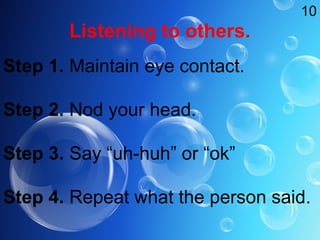roll no 18
- 1. SOCIAL CONVERSATION SKILLS Presented By: Payal kyada(18) Submitted To: Ms. Ibtisam Sorthiya 1
- 3. CONVERSATION A Gossip is one who talks to you about others. A bore is a one who talks to you about himself. A brilliant conversationalist is one who talks to you about yourself. Lisa Kirk 3
- 4. 4
- 5. Meaning Conversation is an informal talk in which people exchange views, feelings and thoughts. Conversation in general is spontaneous, friendly and casual. 5
- 6. CONVERSATION SKILLS • MAGIC KEY TO PERSONAL AND SOCIAL POPULARITY • BUSINESS MEETINGS PAY OFF • EXPRESS YOUR POTENTIAL • KNOW A SENSE OF PERSONAL HAPPINESS • DEVELOP NEW FRIENDSHIPS • STRENGTHEN OLD ONES 6
- 7. Social Conversation Skill Social conversation, also known as chit- chat or small talk attempts to establish a sociable atmosphere. At a tea-party or social gathering, the conversation reveals feelings of togetherness, rather than communicating ideas or any specific meaning. Words are used in symbolic ways as verbal social gestures. This social use of words is known as phatic communion. 7
- 8. 8
- 9. Social conversation skills Listening to others. Starting a conversation with a new or unfamiliar person. Maintaining conversations by asking questions. Ending conversations. 9
- 10. Step 1. Maintain eye contact. Step 2. Nod your head. Step 3. Say “uh-huh” or “ok” Step 4. Repeat what the person said. Listening to others. 10
- 11. Starting a conversation with a new or unfamiliar person. Step 1. Choose the right time and place. Step 2. If you do not know the person, introduce yourself. If you know the person, say “Hi.” Step 3. Choose a topic that you would like to talk about OR ask a question. Step 4. Judge whether the other person is listening and wants to talk. 11
- 12. Maintaining a conversation by Asking a Questions Step 1. Greet the person. Step 2. Ask a question about something you would like to know about. Step 3. Judge whether the person is listening and is interested in pursuing the conversation 12
- 13. Ending a conversation. Step 1. Wait until the other person has finished talking. Step 2. Use a non-verbal gesture such as glancing away or looking at your watch. Step 3. Make a closing comment, such as “well, I really need to go now.” Step 4. Say good-bye. 13
- 14. 14
- 15. CONCLUSION… 15
- 16. 16
Editor's Notes
- on
















